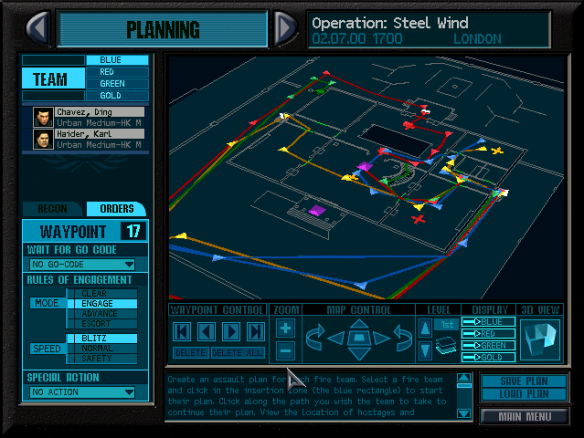I occasionally play computer games like a degenerate.
I began with an Amstrad CPC 464 in the 80s; it often malfunctioned: the cassette-loaded games wouldn’t work properly, and I spent many a Saturday sitting by the computer listening to this. It often progressed nicely until about an hour then suddenly stopped working and I was left in a state of extreme misery and/or rage. Then I got an Amiga, which at least didn’t suffer these mishaps and had some sehr cool games, my favourites often being the free ones bundled with Amiga Power magazine.
When I started reading Serious Literature I came to despise the ways of the lesser man, however in my 3rd year at university I was introduced to Delta Force and Quake 2 and loved them. In my 4th year, I wasted many an hour on Baldur’s Gate, and then after graduation, consigned to NEEThood, I played Rainbow Six Raven Shield for hours.
In the Plague Year 2021 I decided to revisit the game, found it on Steam for something like 50 cents, and had a grand old time. The Rainbow Six series are first-person shooters like Quake or Wolfenstein but as with Delta Force they aim for some measure of verisimilitude. While you can just charge into an enemy area, shooting a machine gun Jesse Venture style from the hip, it likely won’t end well. Where Delta Force was mostly outdoors action, Rainbow Six focuses on oil refineries, hotels, underground tunnel complexes, car dealerships; it was also, as far as I know, the first to incorporate some measure of tactical planning. You could just accept a pre-programmed plan and operative load-out, but it was more fun for me to select the right operatives (each with their own statistics for e.g. Assault, Stealth, Demolitions, Sniper),
equip them as seemed best, and then plan their route with go codes, as I took charge of one team, or sometimes hopped back and forth from team to team since the AI was occasionally retarded. But in theory you could plan out every move and then sit back and watch the game on observer mode.
The original Rainbow Six (from 1998) was fiendishly difficult: even on Recruit settings the enemies had Jelly Bryce reaction times and went for headshots nine times out of ten, rendering armour useless. Basically, the only way to win was to memorise their locations and patrol routes and shoot them in the back or flashbang or frag them round a corner.
The sequels, Rogue Spear, and Raven Shield (2003), were significantly better, with the introduction of snipers and much more realistic AI shooting skills. Raven Shield also had much better graphics: I remember playing it on multiplayer, shooting an adversary then watching, mesmerised, as his body fell down the stairs, his head banging on each stair, until someone else then shot me.
This time I only played single-player as I couldn’t find any decent servers and I’m too old and slow to play against 12-year-olds who’ve never done anything but play vidya. There were some great, atmospheric maps; I especially enjoy wintery missions so enjoyed the Swiss chalet ones very much. I was a bit disappointed that you can’t play Rogue Spear anymore, as it had some fantastic, atmospheric locations like a ruined Kosovo and an Inception-esque arctic base, but there it is.
Raven Shield has a good range of weapons, from standards like the M4 and G36 to the more esoteric Steyr Aug (used by tall blond Karl in Die Hard, incidentally). I would have preferred even more operatives, as I liked to use the British and German operatives but was limited to two SAS men and three Hun. It would have been nice to have had e.g. some Welsh SAS or SBS operatives with names like Dai Davies and a background in sheep rustling.
As far as I know, Raven Shield was the last game to feature tactical planning. It’s a pity, as I enjoyed the unique combination of chess-like tactical planning and reflex-driven shooting. I suspect that the planning phase could be reintroduced in future games, to rejuvenate the genre; while it’s not a new feature, it would be new to most gamers and was never fully developed by the designers.
I also feel the designers could have made more of the operatives’ unique characteristics, e.g. I tended to pair the two SAS operatives, as I just felt they would naturally work together better than with e.g. a South Korean or American operative. Of course it made no difference to their performance but I naturally invest significance in character; and I think this would be a good avenue for future games: so e.g. Russian operatives would perform better in colder, more Russian-like locations, the Brazilian better in hot humid environs; and the German and British operatives would work well in one team, having cross-trained. It would make personnel management more interesting, and make the game more meaningful. It would also be good to have different character responses to stress or injury or fatigue, with some just stoically taking it, others notably slowing down or collapsing, and the Muslim operatives could suddenly turn on their Western colleagues, screaming Allahu Akhbar! and then blowing themselves up.
So, all in all a jolly good way to kill time.
